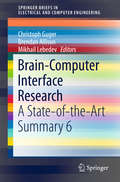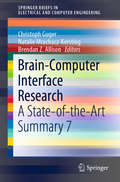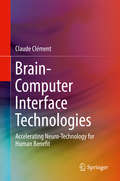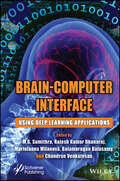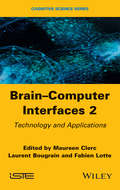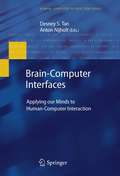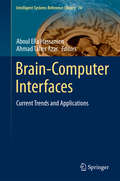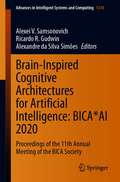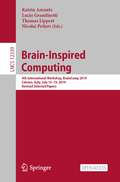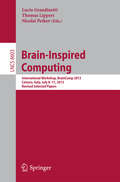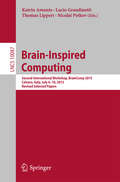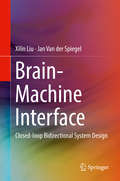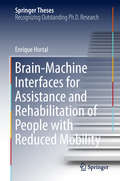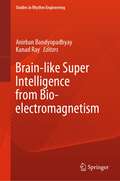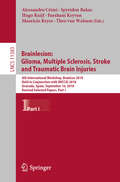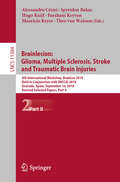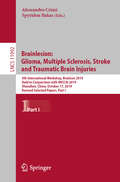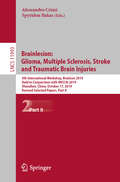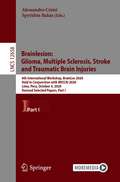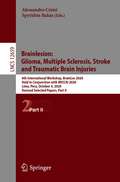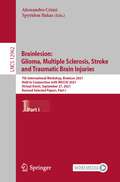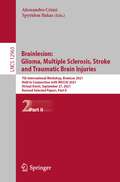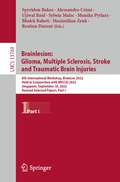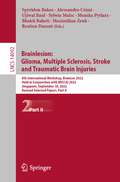- Table View
- List View
Brain-Computer Interface Research: A State-of-the-Art Summary 6 (SpringerBriefs in Electrical and Computer Engineering #6)
by Brendan Allison Christoph Guger Mikhail LebedevBrain-computer interfaces (BCIs) are rapidly developing into a mainstream, worldwide research endeavor. With so many new groups and projects, it can be difficult to identify the best ones. This book summarizes ten leading projects from around the world. About 60 submissions were received in 2011 for the highly competitive BCI Research Award, and an international jury selected the top ten. This Brief gives a concise but carefully illustrated and fully up-to-date description of each of these projects, together with an introduction and concluding chapter by the editors.
Brain-Computer Interface Research: A State-of-the-Art Summary 7 (SpringerBriefs in Electrical and Computer Engineering #6)
by Brendan Z. Allison Christoph Guger Natalie Mrachacz-KerstingEach year, the Annual BCI Research Award recognizes the top new projects in brain-computer interface (BCI) research. This book contains summaries of these projects from the 2017 BCI Research Award. Each chapter is written by the group that submitted the BCI project that was nominated, and introduction and discussion chapters provide supporting information and explore trends that are reflected in the annual awards each year. One of the prominent trends in recent years has been BCIs for new patient groups, and many chapters in this book present emerging research directions that might become more prevalent in the near future.
Brain-Computer Interface Technologies: Accelerating Neuro-Technology for Human Benefit
by Claude ClémentThis book is about the field of brain-computer interfaces (BCI) and the unique and special environment of active implants that electrically interface with the brain, spinal cord, peripheral nerves, and organs. At the heart of the book is the matter of repairing and rehabilitating patients suffering from severe neurologic impairments, from paralysis to movement disorders and epilepsy, that often requires an invasive solution based on an implanted device. Past achievements, current work, and future perspectives of BCI and other interactions between medical devices and the human nervous system are described in detail from a pragmatic point of view.Reviews the Active Implantable Medical Devices (AIMDs) industry and how it is moving from cardiac to neuro applicationsClear, easy to read, presentation of the field of neuro-technologies for human benefitProvides easy to understand explanations about the technical limitations, the physics of implants in the human body, and realistic long terms perspectives
Brain-Computer Interface: Using Deep Learning Applications
by Balamurugan Balusamy M. G. Sumithra Rajesh Kumar Dhanaraj Chandran Venkatesan Mariofanna MilanovaBRAIN-COMPUTER INTERFACE It covers all the research prospects and recent advancements in the brain-computer interface using deep learning. The brain-computer interface (BCI) is an emerging technology that is developing to be more functional in practice. The aim is to establish, through experiences with electronic devices, a communication channel bridging the human neural networks within the brain to the external world. For example, creating communication or control applications for locked-in patients who have no control over their bodies will be one such use. Recently, from communication to marketing, recovery, care, mental state monitoring, and entertainment, the possible application areas have been expanding. Machine learning algorithms have advanced BCI technology in the last few decades, and in the sense of classification accuracy, performance standards have been greatly improved. For BCI to be effective in the real world, however, some problems remain to be solved. Research focusing on deep learning is anticipated to bring solutions in this regard. Deep learning has been applied in various fields such as computer vision and natural language processing, along with BCI growth, outperforming conventional approaches to machine learning. As a result, a significant number of researchers have shown interest in deep learning in engineering, technology, and other industries; convolutional neural network (CNN), recurrent neural network (RNN), and generative adversarial network (GAN). Audience Researchers and industrialists working in brain-computer interface, deep learning, machine learning, medical image processing, data scientists and analysts, machine learning engineers, electrical engineering, and information technologists.
Brain-Computer Interfaces 2: Technology and Applications
by Fabien Lotte Laurent Bougrain Maureen ClercIn this book, the reader will become acquainted with the fundamental notions which need to be brought together to build and run Brain Computer Interfaces. The fields of expertise covered include neurophysiology, signal processing, machine learning, human learning, clinical practice and multimedia. Intended for a general audience, this book provides hands-on illustrations, and the inner works can be understood in detail thanks to freely available software designed with OpenViBE.
Brain-Computer Interfaces: Applying our Minds to Human-Computer Interaction (Human–Computer Interaction Series)
by Anton Nijholt Desney S. TanFor generations, humans have fantasized about the ability to create devices that can see into a person's mind and thoughts, or to communicate and interact with machines through thought alone. Such ideas have long captured the imagination of humankind in the form of ancient myths and modern science fiction stories. Recent advances in cognitive neuroscience and brain imaging technologies have started to turn these myths into a reality, and are providing us with the ability to interface directly with the human brain. This ability is made possible through the use of sensors that monitor physical processes within the brain which correspond with certain forms of thought. Brain-Computer Interfaces: Applying our Minds to Human-Computer Interaction broadly surveys research in the Brain-Computer Interface domain. More specifically, each chapter articulates some of the challenges and opportunities for using brain sensing in Human-Computer Interaction work, as well as applying Human-Computer Interaction solutions to brain sensing work. For researchers with little or no expertise in neuroscience or brain sensing, the book provides background information to equip them to not only appreciate the state-of-the-art, but also ideally to engage in novel research. For expert Brain-Computer Interface researchers, the book introduces ideas that can help in the quest to interpret intentional brain control and develop the ultimate input device. It challenges researchers to further explore passive brain sensing to evaluate interfaces and feed into adaptive computing systems. Most importantly, the book will connect multiple communities allowing research to leverage their work and expertise and blaze into the future.
Brain-Computer Interfaces: Current Trends and Applications (Intelligent Systems Reference Library #74)
by Ahmad Taher Azar Aboul Ella HassanienThe success of a BCI system depends as much on the system itself as on the user's ability to produce distinctive EEG activity. BCI systems can be divided into two groups according to the placement of the electrodes used to detect and measure neurons firing in the brain. These groups are: invasive systems, electrodes are inserted directly into the cortex are used for single cell or multi unit recording, and electrocorticography (EcoG), electrodes are placed on the surface of the cortex (or dura); noninvasive systems, they are placed on the scalp and use electroencephalography (EEG) or magnetoencephalography (MEG) to detect neuron activity. The book is basically divided into three parts. The first part of the book covers the basic concepts and overviews of Brain Computer Interface. The second part describes new theoretical developments of BCI systems. The third part covers views on real applications of BCI systems.
Brain-Computer Interfacing
by Rajesh P. N. RaoThe idea of interfacing minds with machines has long captured the human imagination. Recent advances in neuroscience and engineering are making this a reality, opening the door to restoring and potentially augmenting human physical and mental capabilities. Medical applications such as cochlear implants for the deaf and deep brain stimulation for Parkinson s disease are becoming increasingly commonplace. Brain- computer interfaces (BCIs) (also known as brain- machine interfaces or BMIs) are now being explored in applications as diverse as security, lie detection, alertness monitoring, telepresence, gaming, education, art, and human augmentation. This introduction to the field is designed as a textbook for upper- level undergraduate and first year graduate courses in neural engineering or brain- computer interfacing for students from a wide range of disciplines. It can also be used for self- study and as a reference by neuroscientists, computer scientists, engineers, and medical practitioners. Key features include: Essential background in neuroscience, brain recording and stimulation technologies, signal processing, and machine learning Detailed description of the major types of BCIs in animals and humans, including invasive, semi-invasive, noninvasive, stimulating, and bidirectional BCIs In-depth discussion of BCI applications and BCI ethics Questions and exercises in each chapter Supporting Web site with annotated list of book- related links
Brain-Inspired Cognitive Architectures for Artificial Intelligence: Proceedings of the 11th Annual Meeting of the BICA Society (Advances in Intelligent Systems and Computing #1310)
by Alexei V. Samsonovich Ricardo R. Gudwin Alexandre da Silva SimõesThe book focuses on original approaches intended to support the development of biologically inspired cognitive architectures. It bridges together different disciplines, from classical artificial intelligence to linguistics, from neuro- and social sciences to design and creativity, among others. The chapters, based on contributions presented at the Eleventh Annual Meeting of the BICA Society, held on November 10-14, 2020, in Natal, Brazil, discuss emerging methods, theories and ideas towards the realization of general-purpose humanlike artificial intelligence or fostering a better understanding of the ways the human mind works. All in all, the book provides engineers, mathematicians, psychologists, computer scientists and other experts with a timely snapshot of recent research and a source of inspiration for future developments in the broadly intended areas of artificial intelligence and biological inspiration.
Brain-Inspired Computing: 4th International Workshop, BrainComp 2019, Cetraro, Italy, July 15–19, 2019, Revised Selected Papers (Lecture Notes in Computer Science #12339)
by Lucio Grandinetti Thomas Lippert Nicolai Petkov Katrin AmuntsThis open access book constitutes revised selected papers from the 4th International Workshop on Brain-Inspired Computing, BrainComp 2019, held in Cetraro, Italy, in July 2019. The 11 papers presented in this volume were carefully reviewed and selected for inclusion in this book. They deal with research on brain atlasing, multi-scale models and simulation, HPC and data infra-structures for neuroscience as well as artificial and natural neural architectures.
Brain-Inspired Computing: International Workshop, BrainComp 2013, Cetraro, Italy, July 8-11, 2013, Revised Selected Papers (Lecture Notes in Computer Science #8603)
by Lucio Grandinetti Thomas Lippert Nicolai PetkovThis book constitutes the thoroughly refereed conference proceedings of the International Workshop on Brain-inspired Computing, BrainComp 2013, held in Cetraro, Italy, in July 2013. The 16 revised full papers were carefully reviewed and selected from numerous submissions and cover topics such as brain structure and function as a neuroscience perspective, computational models and brain-inspired computing, HPC and visualization for human brain simulations.
Brain-Inspired Computing: Second International Workshop, BrainComp 2015, Cetraro, Italy, July 6-10, 2015, Revised Selected Papers (Lecture Notes in Computer Science #10087)
by Lucio Grandinetti Thomas Lippert Nicolai Petkov Katrin AmuntsThis book constitutes the thoroughly refereed conference proceedings of the International Workshop on Brain-inspired Computing, BrainComp 2013, held in Cetraro, Italy, in July 2013. The 16 revised full papers were carefully reviewed and selected from numerous submissions and cover topics such as brain structure and function as a neuroscience perspective, computational models and brain-inspired computing, HPC and visualization for human brain simulations.
Brain-Machine Interface: Closed-loop Bidirectional System Design
by Xilin Liu Jan Van der SpiegelThis book provides an introduction to the emerging area of "Brain-Machine Interfaces," with emphasis on the operation and practical design aspects. The book will help both electrical & bioengineers as well as neuroscience investigators to learn about the next generation brain-machine interfaces. The comprehensive review and design analysis will be very helpful for researchers who are new to this area or interested in the study of the brain. The in-depth discussion of practical design issues especially in animal experiments will also be valuable for experienced researchers.
Brain-Machine Interfaces for Assistance and Rehabilitation of People with Reduced Mobility (Springer Theses)
by Enrique HortalThis book reports on the development of different control tools for Brain-machine interface-based assistance and rehabilitation. Brain activity is analyzed with the purpose of classify mental tasks and detecting movement intentions in patients with impaired motility. Event-Related Desynchronization (ERD) and Event-Related Synchronization (ERS) are detected. Throughout this book, different control systems are presented and validated. This thesis, examined at the Miguel Hernández University of Elche, Spain, in 2016, received the award for best thesis in bioengineering from the Bioengineering group of the Spanish Committee of Automatic Control (CEA) in 2017.
Brain-like Super Intelligence from Bio-electromagnetism (Studies in Rhythm Engineering)
by Kanad Ray Anirban BandyopadhyayThis book discusses various aspects of bioinspired technologies but with an additional emphasis on the medical science, starting from the popular article on neurobiology to pure biophysics that ends with the superintelligence of biological systems that could be reverse engineered. It covers eight different aspects of natural intelligence, starting from the fundamental electromagnetic properties of a protein to the vibrations and the resonance of the entire biomaterial system. It also covers a wide spectrum of hierarchical communication among different biological systems for intelligence and then medical science is applied.
Brainlesion: 4th International Workshop, BrainLes 2018, Held in Conjunction with MICCAI 2018, Granada, Spain, September 16, 2018, Revised Selected Papers, Part I (Lecture Notes in Computer Science #11383)
by Alessandro Crimi Mauricio Reyes Theo van Walsum Spyridon Bakas Hugo Kuijf Farahani KeyvanThis two-volume set LNCS 11383 and 11384 constitutes revised selected papers from the 4th International MICCAI Brainlesion Workshop, BrainLes 2018, as well as the International Multimodal Brain Tumor Segmentation, BraTS, Ischemic Stroke Lesion Segmentation, ISLES, MR Brain Image Segmentation, MRBrainS18, Computational Precision Medicine, CPM, and Stroke Workshop on Imaging and Treatment Challenges, SWITCH, which were held jointly at the Medical Image Computing for Computer Assisted Intervention Conference, MICCAI, in Granada, Spain, in September 2018. The 92 papers presented in this volume were carefully reviewed and selected from 95 submissions. They were organized in topical sections named: brain lesion image analysis; brain tumor image segmentation; ischemic stroke lesion image segmentation; grand challenge on MR brain segmentation; computational precision medicine; stroke workshop on imaging and treatment challenges.
Brainlesion: 4th International Workshop, BrainLes 2018, Held in Conjunction with MICCAI 2018, Granada, Spain, September 16, 2018, Revised Selected Papers, Part II (Lecture Notes in Computer Science #11384)
by Alessandro Crimi Mauricio Reyes Theo van Walsum Spyridon Bakas Hugo Kuijf Farahani KeyvanThis two-volume set LNCS 11383 and 11384 constitutes revised selected papers from the 4th International MICCAI Brainlesion Workshop, BrainLes 2018, as well as the International Multimodal Brain Tumor Segmentation, BraTS, Ischemic Stroke Lesion Segmentation, ISLES, MR Brain Image Segmentation, MRBrainS18, Computational Precision Medicine, CPM, and Stroke Workshop on Imaging and Treatment Challenges, SWITCH, which were held jointly at the Medical Image Computing for Computer Assisted Intervention Conference, MICCAI, in Granada, Spain, in September 2018. The 92 papers presented in this volume were carefully reviewed and selected from 95 submissions. They were organized in topical sections named: brain lesion image analysis; brain tumor image segmentation; ischemic stroke lesion image segmentation; grand challenge on MR brain segmentation; computational precision medicine; stroke workshop on imaging and treatment challenges.
Brainlesion: 5th International Workshop, BrainLes 2019, Held in Conjunction with MICCAI 2019, Shenzhen, China, October 17, 2019, Revised Selected Papers, Part I (Lecture Notes in Computer Science #11992)
by Alessandro Crimi Spyridon BakasThe two-volume set LNCS 11992 and 11993 constitutes the thoroughly refereed proceedings of the 5th International MICCAI Brainlesion Workshop, BrainLes 2019, the International Multimodal Brain Tumor Segmentation (BraTS) challenge, the Computational Precision Medicine: Radiology-Pathology Challenge on Brain Tumor Classification (CPM-RadPath) challenge, as well as the tutorial session on Tools Allowing Clinical Translation of Image Computing Algorithms (TACTICAL). These were held jointly at the Medical Image Computing for Computer Assisted Intervention Conference, MICCAI, in Shenzhen, China, in October 2019. The revised selected papers presented in these volumes were organized in the following topical sections: brain lesion image analysis (12 selected papers from 32 submissions); brain tumor image segmentation (57 selected papers from 102 submissions); combined MRI and pathology brain tumor classification (4 selected papers from 5 submissions); tools allowing clinical translation of image computing algorithms (2 selected papers from 3 submissions.)
Brainlesion: 5th International Workshop, BrainLes 2019, Held in Conjunction with MICCAI 2019, Shenzhen, China, October 17, 2019, Revised Selected Papers, Part II (Lecture Notes in Computer Science #11993)
by Alessandro Crimi Spyridon BakasThe two-volume set LNCS 11992 and 11993 constitutes the thoroughly refereed proceedings of the 5th International MICCAI Brainlesion Workshop, BrainLes 2019, the International Multimodal Brain Tumor Segmentation (BraTS) challenge, the Computational Precision Medicine: Radiology-Pathology Challenge on Brain Tumor Classification (CPM-RadPath) challenge, as well as the tutorial session on Tools Allowing Clinical Translation of Image Computing Algorithms (TACTICAL). These were held jointly at the Medical Image Computing for Computer Assisted Intervention Conference, MICCAI, in Shenzhen, China, in October 2019. The revised selected papers presented in these volumes were organized in the following topical sections: brain lesion image analysis (12 selected papers from 32 submissions); brain tumor image segmentation (57 selected papers from 102 submissions); combined MRI and pathology brain tumor classification (4 selected papers from 5 submissions); tools allowing clinical translation of image computing algorithms (2 selected papers from 3 submissions.)
Brainlesion: 6th International Workshop, BrainLes 2020, Held in Conjunction with MICCAI 2020, Lima, Peru, October 4, 2020, Revised Selected Papers, Part I (Lecture Notes in Computer Science #12658)
by Alessandro Crimi Spyridon BakasThis two-volume set LNCS 12658 and 12659 constitutes the thoroughly refereed proceedings of the 6th International MICCAI Brainlesion Workshop, BrainLes 2020, the International Multimodal Brain Tumor Segmentation (BraTS) challenge, and the Computational Precision Medicine: Radiology-Pathology Challenge on Brain Tumor Classification (CPM-RadPath) challenge. These were held jointly at the 23rd Medical Image Computing for Computer Assisted Intervention Conference, MICCAI 2020, in Lima, Peru, in October 2020.* The revised selected papers presented in these volumes were organized in the following topical sections: brain lesion image analysis (16 selected papers from 21 submissions); brain tumor image segmentation (69 selected papers from 75 submissions); and computational precision medicine: radiology-pathology challenge on brain tumor classification (6 selected papers from 6 submissions). *The workshop and challenges were held virtually.
Brainlesion: 6th International Workshop, BrainLes 2020, Held in Conjunction with MICCAI 2020, Lima, Peru, October 4, 2020, Revised Selected Papers, Part II (Lecture Notes in Computer Science #12659)
by Alessandro Crimi Spyridon BakasThis two-volume set LNCS 12658 and 12659 constitutes the thoroughly refereed proceedings of the 6th International MICCAI Brainlesion Workshop, BrainLes 2020, the International Multimodal Brain Tumor Segmentation (BraTS) challenge, and the Computational Precision Medicine: Radiology-Pathology Challenge on Brain Tumor Classification (CPM-RadPath) challenge. These were held jointly at the 23rd Medical Image Computing for Computer Assisted Intervention Conference, MICCAI 2020, in Lima, Peru, in October 2020.* The revised selected papers presented in these volumes were organized in the following topical sections: brain lesion image analysis (16 selected papers from 21 submissions); brain tumor image segmentation (69 selected papers from 75 submissions); and computational precision medicine: radiology-pathology challenge on brain tumor classification (6 selected papers from 6 submissions). *The workshop and challenges were held virtually.
Brainlesion: 7th International Workshop, BrainLes 2021, Held in Conjunction with MICCAI 2021, Virtual Event, September 27, 2021, Revised Selected Papers, Part I (Lecture Notes in Computer Science #12962)
by Alessandro Crimi Spyridon BakasThis two-volume set LNCS 12962 and 12963 constitutes the thoroughly refereed proceedings of the 7th International MICCAI Brainlesion Workshop, BrainLes 2021, as well as the RSNA-ASNR-MICCAI Brain Tumor Segmentation (BraTS) Challenge, the Federated Tumor Segmentation (FeTS) Challenge, the Cross-Modality Domain Adaptation (CrossMoDA) Challenge, and the challenge on Quantification of Uncertainties in Biomedical Image Quantification (QUBIQ). These were held jointly at the 23rd Medical Image Computing for Computer Assisted Intervention Conference, MICCAI 2020, in September 2021. The 91 revised papers presented in these volumes were selected form 151 submissions. Due to COVID-19 pandemic the conference was held virtually.This is an open access book.
Brainlesion: 7th International Workshop, BrainLes 2021, Held in Conjunction with MICCAI 2021, Virtual Event, September 27, 2021, Revised Selected Papers, Part II (Lecture Notes in Computer Science #12963)
by Alessandro Crimi Spyridon BakasThis two-volume set LNCS 12962 and 12963 constitutes the thoroughly refereed proceedings of the 7th International MICCAI Brainlesion Workshop, BrainLes 2021, as well as the RSNA-ASNR-MICCAI Brain Tumor Segmentation (BraTS) Challenge, the Federated Tumor Segmentation (FeTS) Challenge, the Cross-Modality Domain Adaptation (CrossMoDA) Challenge, and the challenge on Quantification of Uncertainties in Biomedical Image Quantification (QUBIQ). These were held jointly at the 23rd Medical Image Computing for Computer Assisted Intervention Conference, MICCAI 2020, in September 2021. The 91 revised papers presented in these volumes were selected form 151 submissions. Due to COVID-19 pandemic the conference was held virtually.
Brainlesion: 8th International Workshop, BrainLes 2022, Held in Conjunction with MICCAI 2022, Singapore, September 18, 2022, Revised Selected Papers (Lecture Notes in Computer Science #13769)
by Alessandro Crimi Spyridon Bakas Ujjwal Baid Sylwia Malec Monika Pytlarz Bhakti Baheti Maximilian Zenk Reuben DorentThis book constitutes the refereed proceedings of the 8th International MICCAI Brainlesion Workshop, BrainLes 2022, as well as the Brain Tumor Segmentation (BraTS) Challenge, the Brain Tumor Sequence Registration (BraTS-Reg) Challenge, the Cross-Modality Domain Adaptation (CrossMoDA) Challenge, and the Federated Tumor Segmentation (FeTS) Challenge. These were held jointly at the Medical Image Computing for Computer Assisted Intervention Conference, MICCAI 2022, in September 2022. The 46 revised full papers presented in these volumes were selected form 65 submissions.The presented contributions describe the research of computational scientists and clinical researchers working on brain lesions - specifically glioma, multiple sclerosis, cerebral stroke, traumatic brain injuries, vestibular schwannoma, and white matter hyper-intensities of presumed vascular origin.
Brainlesion: 8th International Workshop, BrainLes 2022, Held in Conjunction with MICCAI 2022, Singapore, September 18, 2022, Revised Selected Papers, Part II (Lecture Notes in Computer Science #14092)
by Alessandro Crimi Spyridon Bakas Ujjwal Baid Sylwia Malec Monika Pytlarz Bhakti Baheti Maximilian Zenk Reuben DorentThis two volume-set LNCS 13769 and LNCS 14092 constitutes the refereed proceedings of the 8th International MICCAI Brainlesion Workshop, BrainLes 2022, as well as the Brain Tumor Segmentation (BraTS) Challenge, the Brain Tumor Sequence Registration (BraTS-Reg) Challenge, the Cross-Modality Domain Adaptation (CrossMoDA) Challenge, and the Federated Tumor Segmentation (FeTS) Challenge. These were held jointly at the Medical Image Computing for Computer Assisted Intervention Conference, MICCAI 2022, in September 2022. The 46 revised full papers presented in these volumes were selected form 65 submissions.The presented contributions describe the research of computational scientists and clinical researchers working on brain lesions - specifically glioma, multiple sclerosis, cerebral stroke, traumatic brain injuries, vestibular schwannoma, and white matter hyper-intensities of presumed vascular origin.
